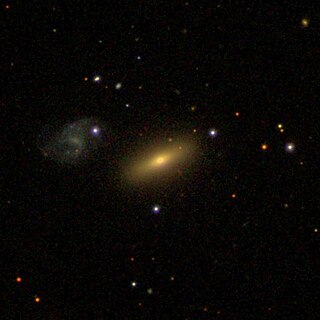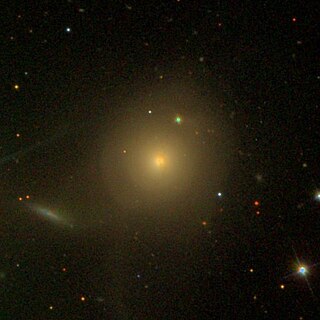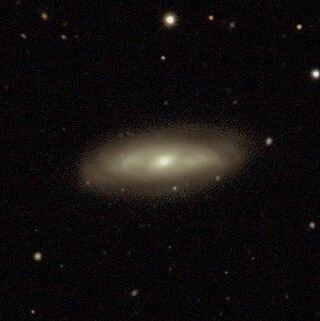
NGC 5821 is a spiral galaxy with a ring structure in the constellation Boötes. It lies near a similarly massed galaxy, NGC 5820, at the same redshift. Both galaxies were discovered by the astronomer William Herschel.

NGC 5545 is a spiral galaxy in the northern constellation of Boötes. It is interacting with the barred spiral galaxy NGC 5544.

NGC 5754 is a barred spiral galaxy located 218 million light years away in the constellation Boötes. It is a member of the Arp 297 interacting galaxies group, which consists of NGC 5752, NGC 5753, NGC 5754, NGC 5755. Along with NGC 2718 and UGC 12158, NGC 5754 is often considered a Milky Way-twin.

NGC 4780 is an intermediate spiral galaxy within the constellation Virgo. It is located about 166 million light-years away from the Sun. It was discovered in 1880 by the astronomer Wilhelm Tempel.

NGC 42 is a lenticular galaxy in the Pegasus constellation. It was discovered on October 30, 1864, by the German astronomer Albert Marth. It may be gravitationally interacting with the nearby NGC 41.

NGC 1728 is a spiral galaxy in the constellation Eridanus. The galaxy is listed in the New General Catalogue. It was discovered on November 10, 1885 by the astronomer Edward Emerson Barnard.

NGC 467 is an unbarred lenticular galaxy in the constellation Pisces. It was discovered on 8 October 1785 by William Herschel.

NGC 159 is a barred lenticular galaxy in the constellation Phoenix. The galaxy was discovered on October 28, 1834, by John Frederick William Herschel.

NGC 1077 is a spiral galaxy in the constellation Perseus. It was discovered on 16 August 1886 by Lewis A. Swift. It was described as "very faint, pretty large, extended" by John Louis Emil Dreyer, the compiler of the New General Catalogue.

NGC 479 is a spiral galaxy in the constellation Pisces. It was discovered by German astronomer Albert Marth on October 27, 1864. It is about 240 million light-years away from Earth.

NGC 1683 is a spiral galaxy in the constellation Orion. The object was discovered in 1850 by the Irish astronomer William Parsons.

NGC 5201 is a spiral galaxy located in the constellation Ursa Major. It was discovered on April 14, 1789 by German-born British astronomer William Herschel. It is about 384 million light years away.

NGC 950 is a barred spiral galaxy in the constellation Cetus. It is approximately 205 million light-years away from the Solar System and has a diameter of about 85,000 light-years. The object was discovered in 1886 by American astronomer and mathematician Ormond Stone.

NGC 670 is a lenticular galaxy located in the Triangulum constellation about 165 million light years from the Milky Way. It was discovered by the German-British astronomer William Herschel in 1786.

NGC 790 is a lenticular galaxy in the constellation Cetus. It is estimated to be 233 million light-years from the Milky Way and has a diameter of approximately 90,000 light years. NGC 790 was discovered on September 10, 1785 by the German-British astronomer William Herschel.

NGC 904 is an elliptical galaxy in the constellation Aries. It is estimated to be 244 million light years from the Milky Way and has a diameter of approximately 85,000 ly. NGC 904 was discovered on 13 December 1884 by the astronomer Edouard Stephan.

NGC 906 is a barred spiral galaxy in the constellation Andromeda in the northern sky. It is estimated to be 215 million light years from the Milky Way and has a diameter of approximately 110,000 ly. NGC 906 was discovered on October 30, 1878 by astronomer Édouard Stephan.

NGC 804 is a lenticular galaxy located in the Triangulum constellation about 231 million light-years from the Milky Way. It was discovered by the American astronomer Lewis Swift in 1885. This galaxy was also observed by the French astronomer Guillaume Bigourdan on December 24, 1897, and it has been added to the Index Catalogue under the symbol IC 1773.

NGC 861 is a spiral galaxy in the constellation Triangulum. It is estimated to be 360 million light-years from the Milky Way and has a diameter of approximately 165,000 light-years. The object was discovered on September 18, 1865 by Heinrich d'Arrest.

NGC 677 is an elliptical galaxy located in the constellation Aries. It was discovered on September 25, 1886, by the astronomer Lewis A. Swift. It is located about 200 million light-years from Earth at the center of a rich galaxy cluster. It has a LINER nucleus.




















